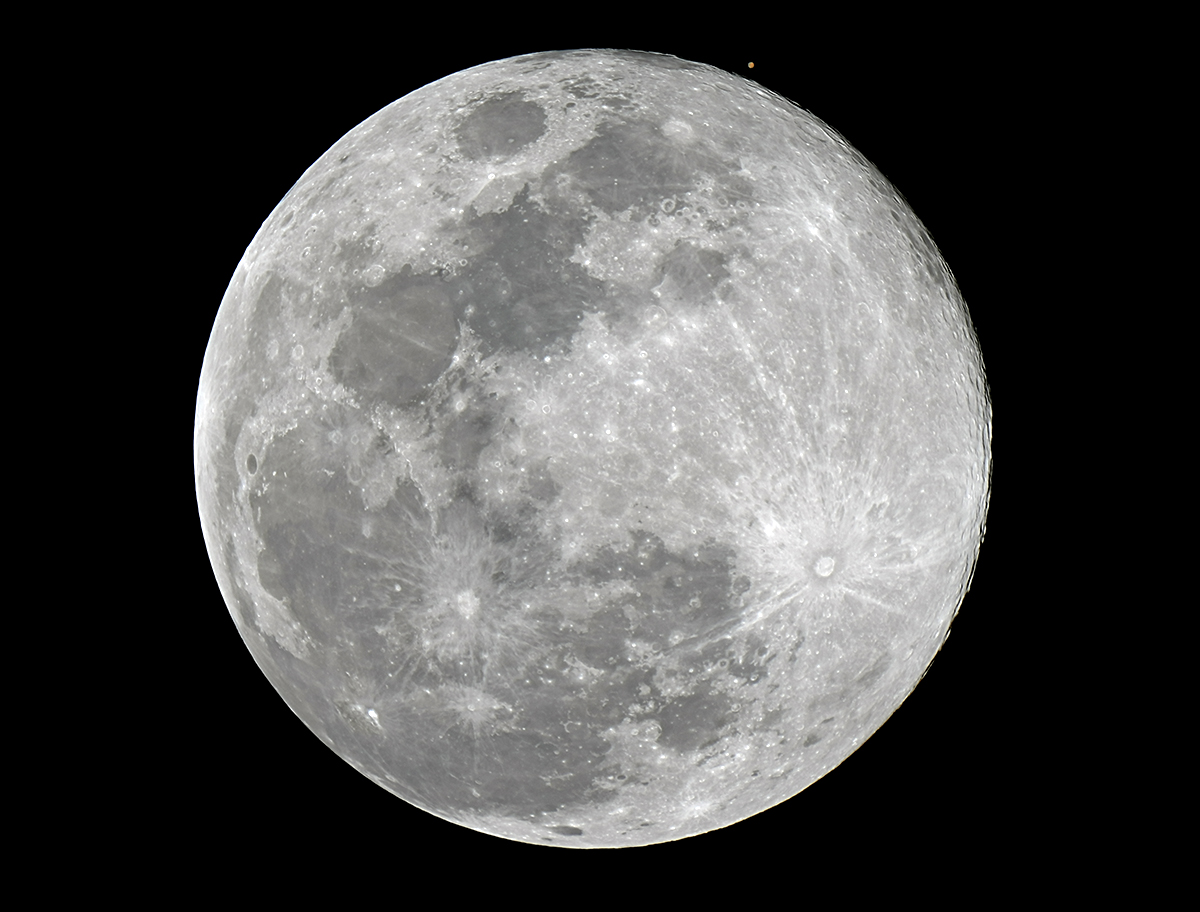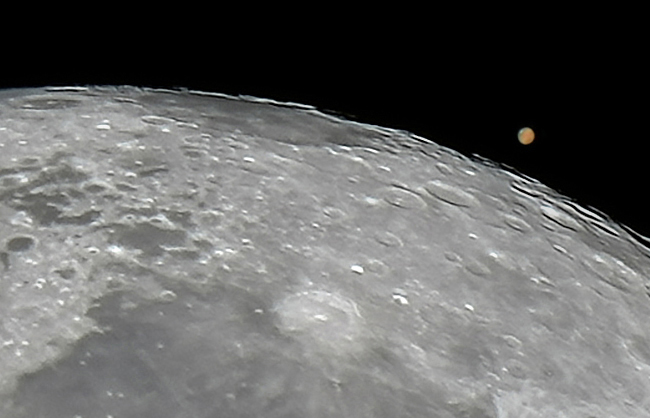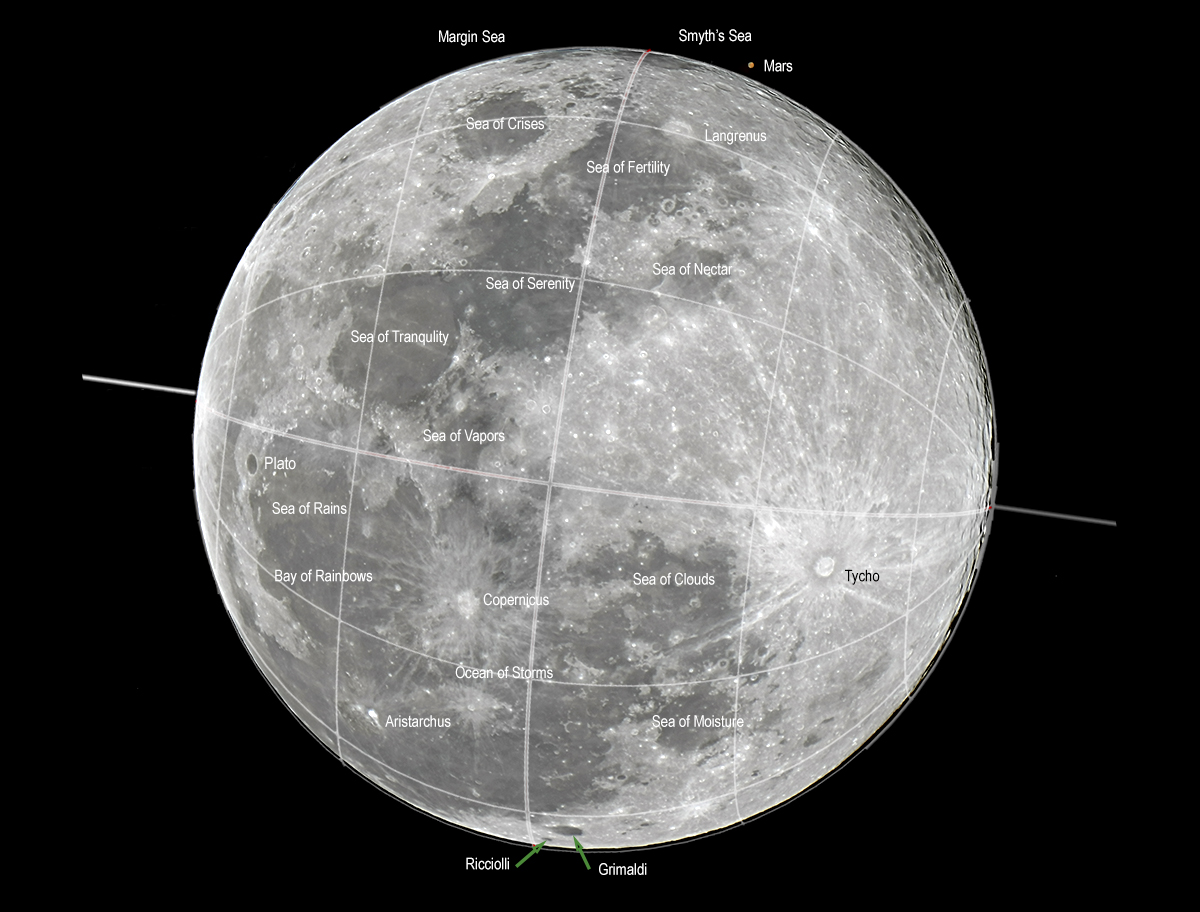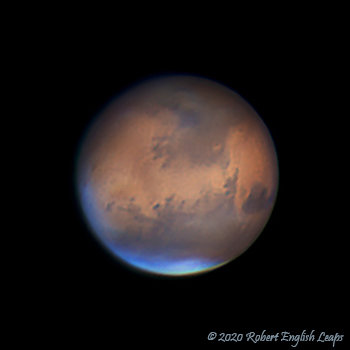The purpose of this feature is to give scout leaders, educators and naturalists an idea of some of the natural events coming up each month. We will try to cover a variety of natural events ranging from sky events to calling periods of amphibians, bird and mammal watching tips, prominent wildflowers and anything else that comes to mind. We will also note prominent constellations appearing over the eastern horizon at mid-evening each month for our area for those who would like to learn the constellations. If you have suggestions for other types of natural information you would like to see added to this calendar, let us know! Though we link book references to nationwide sources, we encourage you to support your local book store whenever possible.
Notes and Images From January 2025 Monday and Tuesday, or at least their celestial counterparts, met a little earlier than normal last month. The days of the week are named after the Sun, the Moon and the five planets easily visible to the naked eye. With one exception, their names have a Norse origin. The exception is named after a Roman god, and is most kids' favorite day of the week. Of the remaining Norse names, Sunday and Monday are the easiest to match with their solar system counterparts. Thursday is only a little more difficult. Think of a god wielding a hammer. Left are Frig, corresponding to the Roman god Venus, Woden, corresponding to the Roman god Mercury, and Tiws, corresponding to the Roman god of war, Mars. On January 13th, the Moon and Mars met in the sky three hours before midnight, with the full Moon passing in front of (occulting) Mars.
Shown above are the Moon and Mars just as Mars was emerging from the occultation.
People are often surprised at how small Mars looks in a telescope compared with the Moon. This is probably because they overestimate the size of Mars, which is only about twice the size of the Moon, and they underestimate the difference in the distance of the two. Mars was about 255 times farther away on this night. If you do the math, it results in Mars appearing less than one-hundredth the size of the Moon. Though Mars in this image does not show much detail, it still amazes me that you can now hand-hold a camera and lens and take an image that shows some surface details on Mars! This full moon was the Wolf Moon, the first full moon of the new year. It was a very cold night! Our footsteps crunched on the unmelted snow that fell a few days before. The sky was beautifully clear, the woods dark and silent. Orion and Canis Major shown brightly over the ridge behind the house. Like most winter full moons, this Wolf Moon looked like it was carved out of ice. Mars was at opposition on this very night and glowed a bright reddish orange.
It was nice to spend some time with the Moon. Some of my first views of the Moon were with a small 60mm refractor given to me by one of my teenage friends. He no longer wanted it, but I loved those magical views of the lunar surface drifting through the field of view. The phases of the Moon are simply a result of looking at a half-lit object from different perspectives. Those perspectives constantly change as the Moon orbits Earth. When we look at a half-lit Moon from mostly the dark side, we see a crescent. If we are looking at the same half-lit Moon mostly from the sunlit side, we see a gibbous phase. Between a new moon and a full moon, the Sun is rising on the unilluminated parts of the Moon. The border between the lit and unlit areas is called the terminator. I spent many evenings watching the Sun rising over the Bay of Rainbows (Sinus Iridum) and watching its rays climb the edge of the crater Copernicus, casting jagged shadows across its floor. I've used the English translation of the Latin names on the image above. There you can find the Sea of Tranquility and the Ocean of Storms, the Sea of Serenity and the Sea of Crisis, the Lake of Dreams and the Lake of Death. When we did night programs with a telescope the Moon always produced what we called the highest "Wow" factor. When kids would look into the telescope they often had trouble looking directly into the eyepiece. I would encourage them and tell them to move their head one way or the other, watching the bright spot of the moonlight projected by the eyepiece on their face. You didn't have to ask when they saw the Moon. Their faces just lit up! They were awestruck by this strange and beautiful landscape. We owe all of those romantic and fanciful lunar names to the 17th century Italian astronomer Giovanni Riccioli and his student Francesco Maria Gremaldi. Gremaldi drew the maps based on their observations of the Moon and Riccioli named the lunar features. Both were Jesuit priests, and they could not publicly endorse at that time the unpopular (and heretical!) Copernican theory that the Earth revolves around the Sun. But Riccioli respected Copernicus and named perhaps the Moon's most beautiful crater after him. To those in power who asked why he made that choice, he had a ready reply. He said that he placed Copernicus in the Ocean of Storms. I like Riccioli. Look at the two craters for Riccioli and Grimaldi in the image above. Note that Riccioli named a much larger crater for his student Gremaldi than he did for himself. But there is an additional reason for that I think. Imagine the phases of the moon from a new moon to a full moon as a two-week time-lapse movie. On the image above, you would first see a thin crescent moon at the top of the image and then watch as the sun rose and the terminator moved downward across the Moon as it's shown in the image. As it does so, it slowly reveals Riccioli's and Grimaldi's beautiful map, a roll of honor written across the Moon. Then, just before the full moon, it's time to run the credits. Just as the Sun's rays climb the rim of the last easily visible crater on the Moon to be revealed, Riccioli modestly signs his name.
Sky Events for February 2024: Evening Sky: Venus and a waxing crescent Moon make a pretty pair on February 1st. At dusk look towards the southeast about 30 degrees above the horizon. Venus will appear lower each night as the month progresses. On a larger scale, Venus and Jupiter and Mars are all bright in the sky this month and can easily be spotted in the early evening. Saturn is about 23 degrees above the southwest horizon at dusk at the beginning of the month. Find Venus and the Moon, then look about 10 degrees (about a fist's width) below to find Saturn. It is much fainter than Venus.
There's a lot to see on Jupiter. Even with just a good pair of binoculars you can see Jupiter appears as a small disk rather than a star-like point. You can often see one or more of the four Galilean moons. One of Galileo's great discoveries was these four moons, though the names presently used (Io, Europa, Calisto and Ganymede) were suggested by his archrival Simon Marius. The movement of the moons is noticeable even over the course of one evening. A six-inch aperture telescope will show the Great Red Spot, a long-lasting, Earth-sized storm in Jupiter's clouds shown in the image at right, and some of the belts, though the belts have lower contrast visually than they appear in images. The planet rotates in just under 10 hours, so in a single night you can watch the Great Red Spot rotate from one side of the planet to the other.
I've had some very memorable experiences observing Mars over the years. I love to spend relaxed time just looking for surface details. I once spotted a feature on the planet's surface that was named Nodus Alcyonius. That led me to the Greek mythology and Ovid's telling of the legend of Alcyone and Ceyx, which in turn led me to the origin of the scientific name of our Belted Kingfisher. I've never looked at kingfishers the same way since. If you are interested in the history of Mars observations, the "canals" and other Mars trivia, you can find a much more in depth discussion here. Though you will need binoculars, you may be able to spot Saturn and Mercury as they cross paths on Monday, February 24th. Look low above the west-southwest horizon after sunset. You will need a very flat horizon, as they will only be about 5 degrees above the true horizon and the sky will still be somewhat bright. Constellations:
The views below show the sky looking east at 9:30pm CST on February 7th. The first view shows the sky with the constellations outlined and names depicted. Star and planet names are in green. Constellation names are in blue. The second view shows the same scene without labels. Ursa Major, the Great Bear, is now prominent in the northeast. It contains quite a few bright galaxies and other deep sky objects. The nearby galaxies Messier 81 and Messier 82 can be spotted as dim small glows with binoculars on dark moonless nights. All of the bright stars of Leo, the Lion, are visible now, including Denebola, the bright star at the tip of the Lion's tail. Part of the constellation of Virgo is visible below Leo. It's handy to know where Denebola is, because below it, if you imagine sliding down the Lion's tail, is the great Virgo cluster of galaxies.The Dolphin Head Nebula, shown in the image above, is a Wolf-Rayet star that is illuminating cast-off layers of its atmosphere. It will explode as a supernova sometime in the future and will ultimately become a black hole. Most of the wispy nebulosity you see in the image is ionized oxygen. Left of Denebola, on a line towards the handle end of the "big dipper," you will see the faint star cluster Mellotte 111, in Coma Berenices. The little constellation of Crater has now cleared the horizon.
On Learning the
Constellations: We advise learning a few constellations each month, and then following them through the seasons. Once you associate a particular constellation coming over the eastern horizon at a certain time of year, you may start thinking about it like an old friend, looking forward to its arrival each season. The stars in the evening scene above, for instance, will always be in the same place relative to the horizon at the same time and date each February. In particular, learn the brightest stars (like Regulus and Denebola in the above scene), for they will guide you to the fainter stars. Once you can locate the more prominent constellations, you can "branch out" to other constellations around them. It may take you a little while to get a sense of scale, to translate what you see on the computer screen or what you see on the page of a book to what you see in the sky. Look for patterns, like the stars of Leo. The earth's rotation causes the constellations to appear to move across the sky just as the Sun and the Moon appear to do. If you go outside earlier than the time shown on the charts, the constellations will be lower to the eastern horizon. If you observe later, they will have climbed higher. As each season progresses, the earth's motion around the sun causes the constellations to appear a little farther towards the west each night for any given time of night. If you want to see where the constellations in the above figures will be on March 15th at 10:00pm EST, you can stay up till 12:00am EST on the February 16th and get a preview. The westward motion of the constellations is equivalent to two hours per month. Recommended: Sky & Telescope's Pocket Star Atlas is beautiful, compact star atlas. A good book to learn the constellations is Patterns in the Sky, by Hewitt-White. For sky watching tips, an inexpensive good guide is Secrets of Stargazing, by Becky Ramotowski.
A good general reference book on astronomy is the Peterson
Field Guide,
A Field Guide to the Stars and Planets, by Pasachoff. The book retails for around $14.00.
The Virtual Moon Atlas is a terrific way to learn the surface features of the Moon. And it's free software. You can download the Virtual Moon Atlas here. Apps: The Sky Safari 6 basic version is free and a great aid for the beginning stargazer. I really love the Sky Safari 6 Pro. Both are available for iOS and Android operating systems. There are three versions. The Pro is simply the best astronomy app I've ever seen. The description of the Pro version reads, "includes over 100 million stars, 3 million galaxies down to 18th magnitude, and 750,000 solar system objects; including every comet and asteroid ever discovered." You may also want to try the very beautiful app Sky Guide. Though not as data intensive as Sky Safari, Sky Guide goes all out to show the sheer beauty of the night sky. Great for locating the planets. A nother great app is the Photographer's Ephemeris. Great for finding sunrise, moonrise, sunset and moonset times and the precise place on the horizon that the event will occur. Invaluable not only for planning photographs, but also nice to plan an outing to watch the full moon rise. Available for both androids and iOS operating systems.
Amphibians:
Recommended: The Frogs and Toads of North America, Lang Elliott, Houghton Mifflin Co.
Archives (Remember to use the back button on your browser, NOT the back button on the web page!) Natural Calendar December 2024 Natural Calendar November 2024 Natural Calendar September 2024 Natural Calendar February 2024 Natural Calendar September 2023 Natural Calendar February 2023 Natural Calendar September 2022 Natural Calendar February 2022 Natural Calendar December 2021 Natural Calendar November 2021 Natural Calendar September 2021 Natural Calendar February 2021 Natural Calendar December 2020 Natural Calendar November 2020 Natural Calendar September 2020 Natural Calendar February 2020 Natural Calendar December 2019 Natural Calendar November 2019 Natural Calendar September 2019 Natural Calendar February 2019 Natural Calendar December 2018 Natural Calendar September 2018 Natural Calendar February 2018 Natural Calendar December 2017 Natural Calendar November 2017 Natural Calendar October 2017Natural Calendar September 2017 Natural Calendar February 2017 Natural Calendar December 2016 Natural Calendar November 2016 Natural Calendar September 2016Natural Calendar February 2016 Natural Calendar December 2015 Natural Calendar November 2015 Natural Calendar September 2015 Natural Calendar November 2014 Natural Calendar September 2014 Natural Calendar September 2013 Natural Calendar December 2012 Natural Calendar November 2012 Natural Calendar September 2012 Natural Calendar February 2012 Natural Calendar December 2011 Natural Calendar November 2011 Natural Calendar September 2011 Natural Calendar December 2010 Natural Calendar November 2010 Natural Calendar September 2010 Natural Calendar February 2010 Natural Calendar December 2009 Natural Calendar November 2009 Natural Calendar September 2009 Natural Calendar February 2009 Natural Calendar December 2008 Natural Calendar November 2008 Natural Calendar September 2008 Natural Calendar February 2008 Natural Calendar December 2007 Natural Calendar November 2007 Natural Calendar September 2007 Natural Calendar February 2007 Natural Calendar December 2006 Natural Calendar November 2006 Natural Calendar September 2006 Natural Calendar February 2006
Natural Calendar December 2005
Natural Calendar November 2005
Natural Calendar September 2005
Natural Calendar February 2005
Natural Calendar December 2004
Natural Calendar November 2004
Natural Calendar September 2004
Natural Calendar February 2004
Natural Calendar December 2003
Natural Calendar November 2003 Natural Calendar February 2003 Natural Calendar December 2002 Natural Calendar November 2002 Nature Notes Archives: Nature Notes was a page we published in 2001 and 2002 containing our observations about everything from the northern lights display of November 2001 to frog and salamander egg masses. Night scenes prepared with The Sky Professional from Software Bisque All images and recordings © 2025 Leaps
|
|








